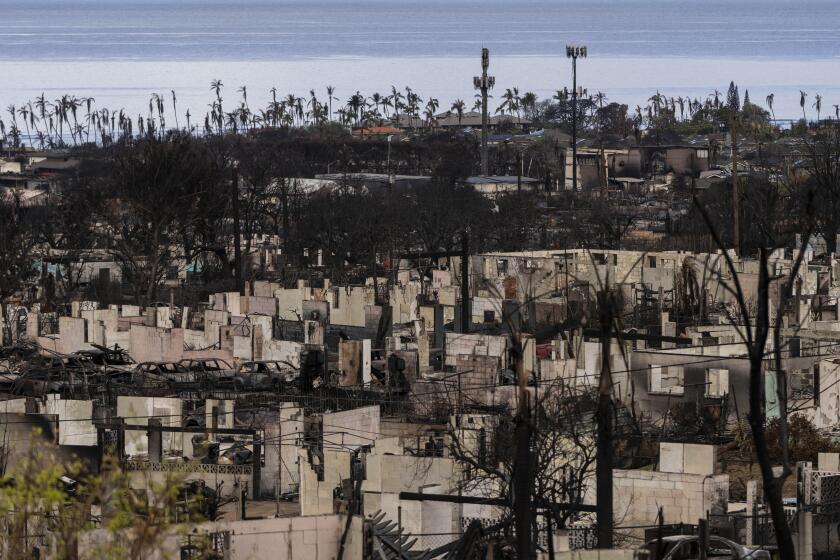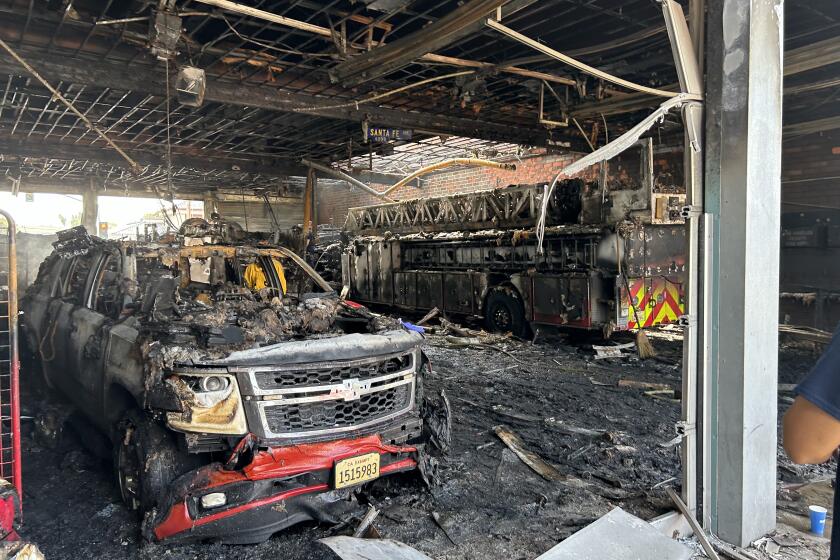Firefighters Battling to Contain Blaze Get Assist From Weather
A fast-spreading wildfire that destroyed a biological research facility, scorched 15,600 acres of rolling chaparral and prompted the evacuation of hundreds of residents over the last three days appeared to be slowing in the face of cooler weather, authorities said Friday.
Dry lightning sparked the so-called Coyote fire about 1 p.m. Wednesday in the Chihuahua Valley, about 30 miles south of Temecula. Firefighters and helicopter crews from as far away as Fresno and Tulare counties have struggled to contain even a small portion of the blaze, the largest in Southern California this season. Firefighters from Riverside and San Diego counties have set fires to clear vegetation from the wildfire’s path, doused buildings with fire-retardant foam and dropped chemicals from aircraft.
By Friday evening, the California Department of Forestry and Fire Prevention said it believed those efforts were paying off and that it had managed to contain more than 19% of the fire. Officials said they hope to have the fire fully contained by Wednesday. “We’re hopeful that the worst has passed,” said department spokesman Bill Peters. “The next couple of days will be critical to see what kind of weather develops.”
Although thunderstorms in the forecast would pour welcome rain on the blazing hills, the threat of new lightning-sparked grass fires troubled officials.
“That potential threat is still here,” Peters said.
On Wednesday, authorities evacuated 125 Chihuahua Valley residents and 600 campers at the Boy Scouts’ Lost Valley Scout Reservation, 12 miles northeast of Warner Springs.
By Thursday, fire swept through the Sky Oaks Biological Field Station, a 1,600-acre outdoor laboratory that has been researching the environmental effects of greenhouse gases. Two residential trailers, a research structure, six environmental enclosures, several monitoring towers and hundreds of thousands of dollars’ worth of equipment were destroyed, according to the forestry department and San Diego State University, which operates the station.
“We were hit really hard,” said Walter Oechel, a university biology professor and program director. “This is a big setback for us. Fortunately, we didn’t have any researchers there at the time.”
Later Thursday, a three-mile wall of flames began advancing on the Boy Scout camp. Firefighters responded by covering structures with foam and creating their own lines of fire. By burning vegetation in front of the wildfire, they denied the larger fire fuel, officials said. “We’re fighting fire with fire,” said forestry department spokesman Martin Johnson.
By Friday evening, five canvas tents and a trailer had burned, but the camp’s cafeteria and meeting rooms escaped damage.
The fire has been spreading mostly to the east toward the remote Anza-Borrego Desert State Park, away from many homes and structures that earlier appeared threatened.
Bruce Peterman, who lives on Rim Rock Road, about two miles north of the fire, said that from his vantage point, the fire appeared to have slowed. Though he had packed many of his belongings for quick evacuation on Wednesday, most of it had been unpacked on Friday, he said.
“The situation has changed,” Peterman said. “It’s all died down. It was raging pretty bad Wednesday. Yesterday it was a slow progression, kind of traveling west. Today it’s just smoldering.”
Fire officials said that 1,344 firefighters, 20 helicopters, seven air tankers, 42 fire engines and 12 bulldozers were battling the flames. No injuries had been reported by Friday evening.
Chihuahua Valley Road resident Mike Smith, 59, lives two miles from the scorched Sky Oaks research facility. Smith said he and his family left their home and spent Thursday night at the Oak Grove Campground on California Highway 79 with other evacuees. Among the possessions they took with them were his daughter’s horses that had been stabled nearby.
Authorities lifted the voluntary evacuation Friday but, while dozens of residents returned to their homes, Smith said he and his family would spend another night at the campground.
“Our real concern is if they can’t stop the fire from coming down to Warner Springs, there’s a good chance it’ll come back this way if the wind shifts,” Smith said. “I don’t want to bring the horses and the trailer up again until we’re darn sure.”
*
Cho reported from Warner Springs and Morin from Los Angeles.
More to Read
Start your day right
Sign up for Essential California for news, features and recommendations from the L.A. Times and beyond in your inbox six days a week.
You may occasionally receive promotional content from the Los Angeles Times.







